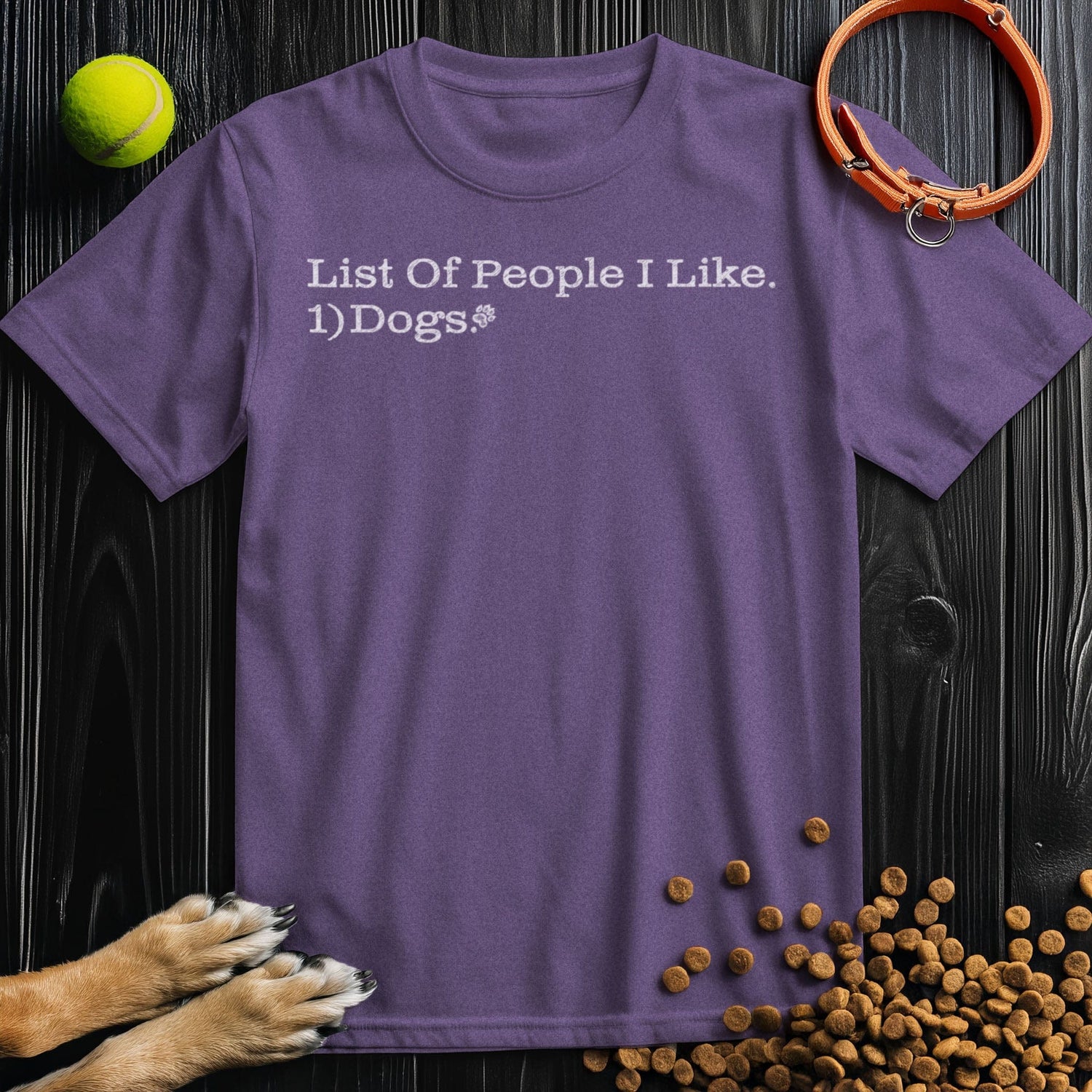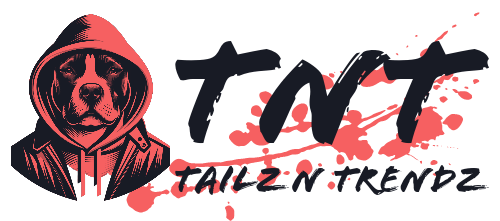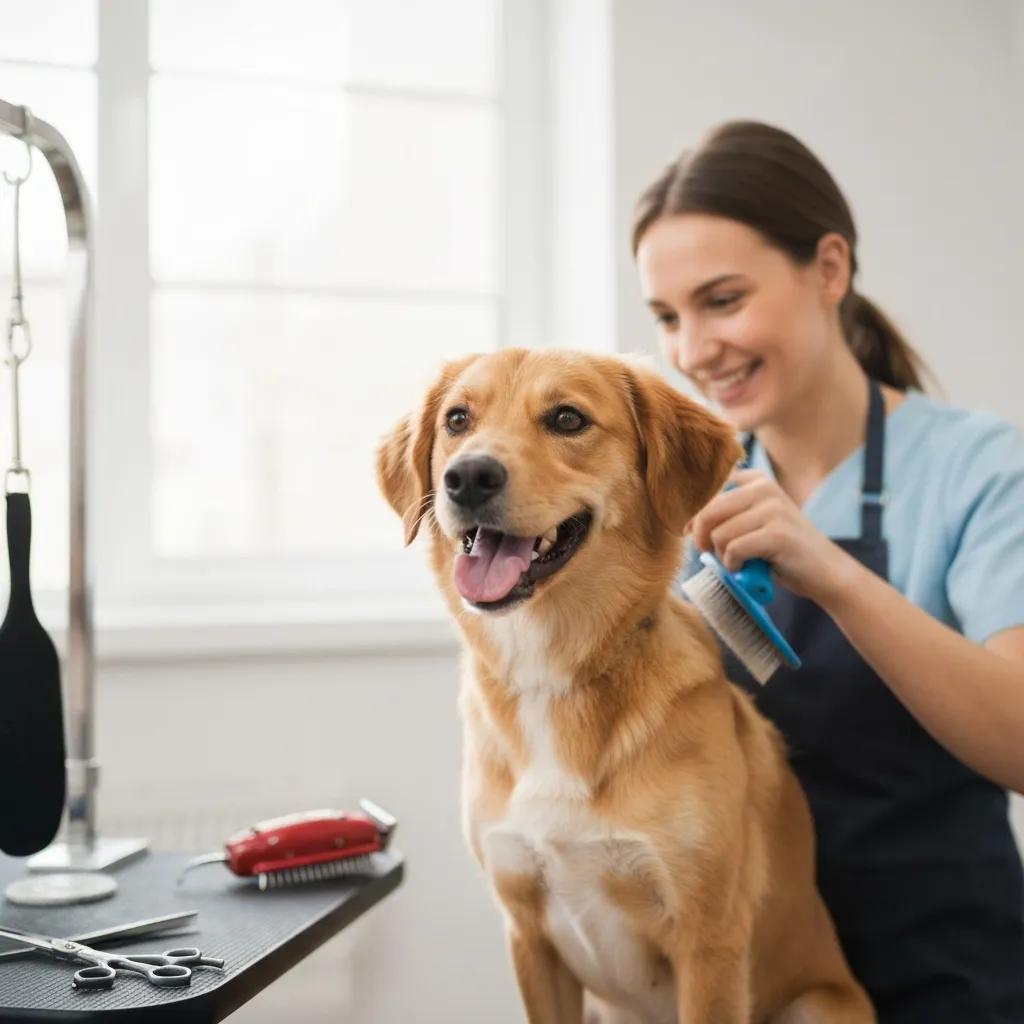A person gently grooming a contented dog, highlighting key dog grooming advice for optimal pet health and care
Mastering dog grooming goes beyond just keeping your furry friend looking sharp; it's a vital part of their overall health, helping to ward off potential issues and forging a stronger connection between you. If you've ever found yourself wrestling with stubborn mats, struggling to trim nails, or dealing with irritated skin, you know that grooming can sometimes feel like a chore. This comprehensive guide is packed with practical dog grooming advice—covering everything from establishing a routine and bathing best practices to nail care, ear cleaning, and selecting the right gear—so you can ensure your dog is always feeling, looking, and performing at their absolute best. We'll dive into:
- How often to groom and how to set up regular check-ins
- The best bathing techniques and gentle, skin-friendly products
- Safe and effective nail trimming methods
- Step-by-step ear cleaning to prevent infections
- How to pick the perfect brushes, clippers, and other essential tools
- Solutions for common issues like mats, grooming anxiety, and breed-specific needs
With these expert dog grooming tips, you'll feel confident creating a grooming routine that not only boosts your dog's health and comfort but also makes the entire experience enjoyable for both of you.
How Often Should You Groom Your Dog?
Consistent grooming is key to maintaining a healthy coat, preventing painful mats, and catching any early signs of skin problems or parasites. Aiming for grooming sessions every 4 to 8 weeks strikes a good balance, keeping your dog looking great without overwhelming their skin or your schedule. A regular routine also helps your dog get used to the process, making each grooming session smoother and more positive.
What Factors Influence Dog Grooming Frequency?
The ideal grooming frequency for your dog depends on several factors, including their coat type, age, how active they are, and any existing health conditions. Breeds with long fur tend to develop mats more quickly, while dogs who love exploring the outdoors will likely need more frequent baths to wash away dirt. Older dogs or those with sensitive skin might benefit from gentler, more frequent touch-ups. Understanding these nuances ensures your dog receives the best possible care for their coat and skin without unnecessary stress.
How to Create a Regular Grooming Schedule for Your Dog
Setting up a grooming calendar makes the process consistent and predictable for both you and your dog.
- Take a look at your dog's coat length and how much they shed to determine how often they need brushing.
- Mark specific dates on your calendar each month for full grooming appointments.
- Pay attention to seasonal shifts—your dog might shed more heavily in the spring and fall, requiring extra brushing during those times.
- Keep track of any skin issues or parasite concerns to help you adjust bathing frequency as needed.
Having a reliable schedule means you won't be caught off guard and your dog will learn to anticipate calm, reassuring grooming sessions. This plan also allows you to easily adapt to changes in weather or your dog's health.
When Is It Time to Visit a Professional Groomer?
It's time to call in the professionals when mats are too tough to tackle at home, the quick of the nail is too close to trim safely, or you notice signs of skin infection. Professional groomers are equipped to handle complex haircuts, flea and tick treatments, and extensive dematting with expertise. They also provide a controlled, supportive environment that's ideal for anxious dogs who may find grooming at home overwhelming.
What Are the Best Dog Bathing Tips for a Clean and Healthy Coat?

Bathing your dog correctly is all about striking a balance between getting them clean and preserving their natural skin oils and protective barrier. A well-executed bath removes dirt, allergens, and loose hair without stripping essential moisture or causing skin irritation.
How Often Should You Bathe Your Dog?
Generally, bathing your dog every 4 to 6 weeks is sufficient, unless they get particularly dirty from outdoor adventures or develop an oily coat between sessions. Bathing too frequently can disrupt your dog's skin's natural balance, leading to dryness, irritation, or flakiness. Adjust the frequency based on your dog's lifestyle, coat type, and any advice from your veterinarian regarding skin conditions.
Dog Hygiene Explained With Dr. Jeff Werber
Dr. Jeff Werber, a veterinarian with over 35 years of experience, advises that bathing frequency for dogs depends on factors like coat type, activity level, and skin conditions. He suggests bathing a dog once a month to prevent skin dryness from overbathing, while emphasizing the use of pet-specific shampoos.
This expert veterinary insight reinforces the recommendation to bathe dogs every 4-6 weeks, highlighting the importance of maintaining a balance between cleanliness and preserving natural skin oils, as well as the crucial role of using appropriate products.
Which Dog Shampoos and Conditioners Are Safe and Effective?
Opt for gentle, pH-balanced formulas that support healthy skin and a lustrous coat. Hypoallergenic shampoos containing ingredients like oatmeal, aloe vera, or coconut oil can soothe sensitive skin, while conditioners with glycerin help lock in moisture. It's best to steer clear of products with sulfates, parabens, or artificial fragrances, as these can often trigger itching or allergic reactions.
How to Bathe Puppies and Senior Dogs Safely
When bathing puppies, use lukewarm water, a minimal amount of shampoo, and provide gentle support to prevent them from getting chilled. Senior dogs often appreciate extra cushioning in the tub and a gentler water flow to ease any joint discomfort. In both cases, ensure you support your dog's body securely, rinse them thoroughly, and dry them gently with absorbent towels to prevent any dampness-related skin issues.
How Can You Prevent Skin Irritation During Baths?
Common missteps like using human shampoo, water that's too hot, or not rinsing thoroughly can lead to skin inflammation. Always test a shampoo's strength on a small area first, rinse until the water runs completely clear, and pat your dog dry instead of rubbing vigorously. Applying a light mist of leave-in conditioner or a skin-soothing serum afterward can further calm any lingering sensitivity.
How Do You Trim Your Dog’s Nails Safely and Effectively?
Proper nail trimming is essential for preventing pain, correcting abnormal gait, and avoiding infections. A safe trimming routine involves carefully removing excess length without accidentally cutting into the quick, which is the sensitive tissue inside each nail.
Epidemiology and Clinical Management of Nail Clipping in Dogs Under UK Primary Veterinary Care
A large 2025 study by the Royal Veterinary College found that nail clipping is a common and essential welfare procedure for dogs, with overgrown nails being a frequent issue leading to pain and mobility problems. The study identified breed-specific needs and highlighted the importance of veterinary-led guidance for optimal nail care.
This study powerfully emphasizes the critical importance of correct nail trimming, aligning perfectly with the article's focus on preventing pain, gait issues, and infections that can arise from overgrown nails.
What Tools Are Best for Dog Nail Trimming and Grinding?
Before you begin, make sure you have these tools ready:
- Guillotine Clippers: Ideal for small to medium-sized nails.
- Scissor Clippers: Best for large, thick nails.
- Electric Grinders: Perfect for smoothing edges.
| Tool Type | Best For | Benefit |
|---|---|---|
| Guillotine Clippers | Small breeds, quick control | Precise cuts reduce splitting |
| Scissor Clippers | Thick nails, large breeds | Powerful leverage for thick nails |
| Electric Grinders | Fine finishing, smoothing | Eliminates sharp edges quickly |
Using a combination of clippers and grinders ensures your dog's nails are trimmed to the right length and their edges are smoothed to prevent snagging on carpets or skin.
How to Avoid Cutting the Quick and Manage Bleeding
To locate the quick, examine the translucent part of the nail for a pinkish hue. Trim small sections at a time, holding the clippers perpendicular to the nail. If you accidentally nick the quick and cause bleeding, apply styptic powder or cornstarch with gentle pressure until the bleeding stops. Staying calm yourself will help reassure your dog and minimize stress if a small accident occurs.
How to Recognize and Treat Overgrown Nails
Overgrown nails often have a noticeable curve, make a clicking sound on hard floors, and can even affect your dog's paw alignment. Your dog might seem hesitant to walk or develop calluses. If nails are significantly overgrown, trim them back gradually over several sessions to avoid cutting into the quick. For very long nails, it's best to consult a professional groomer or veterinarian to ensure safe and effective trimming.
When Should You Seek Veterinary or Groomer Help for Nail Care?
If your dog becomes very resistant to nail trimming, has unusually shaped nails, or shows signs of infection like redness, discharge, or limping, it's time to seek professional help. Veterinarians can treat ingrown nails or infections, while groomers can safely manage difficult nail shapes using specialized tools and expertise.
What Are the Essential Dog Ear Cleaning Tips to Prevent Infections?
Regular ear care is crucial for removing wax, debris, and moisture that can create a breeding ground for bacteria or yeast. Gentle cleaning helps prevent chronic infections and keeps your dog comfortable.
How to Clean Your Dog’s Ears Step-by-Step
Follow these steps in a calm, relaxed environment:
- First, inspect your dog's ears for any signs of redness, unusual odor, or excessive wax buildup.
- Gently apply a veterinarian-approved ear cleaning solution directly into the ear canal.
- Massage the base of the ear for about 30 seconds to help loosen any debris.
- Use a soft, lint-free pad to carefully wipe away the loosened wax and dirt.
- Continue this process until the pads come away clean.
This method effectively removes wax and dirt without pushing debris further into the ear, creating an environment that discourages infections.
Which Ear Cleaning Solutions Are Recommended for Dogs?
Look for solutions that contain gentle surfactants and natural antimicrobial agents. Ingredients like chlorhexidine, apple cider vinegar (properly diluted for pH balance), or glycolic cleansers are often recommended. It's best to avoid formulas containing alcohol, as they can sting or excessively dry out sensitive ear tissues.
What Are the Signs of Dog Ear Infections?
Keep an eye out for persistent scratching at the ears, frequent head shaking, a foul odor emanating from the ears, dark or unusual discharge, or swollen ear flaps. These symptoms often indicate an overgrowth of yeast or bacteria, and it's important to consult your veterinarian for an accurate diagnosis and appropriate treatment.
How Can You Prevent Common Ear Problems in Dogs?
Regularly checking your dog's ears after swimming or bathing, keeping ear hair trimmed for breeds with floppy ears, and ensuring their ear canals are thoroughly dried can significantly reduce moisture buildup. Incorporating ear checks into your regular grooming routine helps you spot any discomfort early on and keep potential infections at bay.
How Can You Choose and Use the Right Dog Grooming Tools?
Selecting the correct grooming equipment can make the process more efficient, safer, and comfortable for both you and your dog. Using tools that are appropriate for your dog's specific coat type and the grooming task at hand will help you achieve professional-quality results at home.
What Types of Brushes Are Best for Different Coat Types?
Different brush designs are tailored to address specific hair characteristics and effectively remove various types of debris:
| Brush Type | Coat Type | Primary Function |
|---|---|---|
| Slicker Brush | Long, curly coats | Removes mats and tangles |
| Bristle Brush | Short, smooth coats | Distributes natural oils |
| Pin Brush | Double coats | Loosens dead undercoat |
| Rubber Curry | Short, wiry coats | Massages skin, lifts dirt |
How to Select the Right Clippers and Nail Trimmers
When choosing clippers and trimmers, prioritize ergonomic design and high-quality blades. Look for clippers with high-torque, low-noise motors to minimize your dog's anxiety and ensure consistent cutting. Remember to replace blades regularly and select sizes that are suitable for your dog's coat thickness. For nail trimmers, ensure they have sharp, rust-resistant edges and comfortable grips to provide you with optimal control during clipping.
What Are the Benefits of Using Specialized Grooming Products?
Products specifically designed for grooming challenges, such as shampoos for flea control, conditioners with anti-static properties, and detangling sprays, can make a significant difference. These specialized items not only support overall coat health and make it easier to remove mats but also can reduce drying time, leading to a shinier, healthier coat and a more relaxed grooming experience.
How to Maintain and Clean Your Grooming Tools
After each dog grooming session, remove any trapped hair from brushes and blades. Wash them with mild detergent and ensure they are completely dry to prevent rust or bacterial growth. Regularly lubricate clipper blades and store your tools in a well-ventilated, organized case. Keeping your equipment clean and well-maintained will extend its lifespan and ensure hygienic grooming every time.
How Do You Manage Common Dog Grooming Challenges?
Dealing with behavioral resistance, stubborn tangles, or parasite infestations can turn grooming into a difficult ordeal. Employing targeted strategies can help reduce stress and maintain your dog's coat health, even in challenging situations.
How to Groom Dogs with Mats and Tangles Safely
Begin mat removal by applying a detangling spray generously around the matted area. Gently hold the fur close to the skin to avoid pulling, and use a wide-tooth comb or a mat splitter to carefully break apart the tangled fibers. Gradual detangling is key to preserving skin integrity and minimizing discomfort before you finish with a slicker brush.
What Are Effective Strategies to Reduce Grooming Anxiety?
Building your dog's tolerance through short, positive grooming sessions is highly effective. Offer treats, praise, and short breaks every few minutes. Introduce grooming tools gradually—let your dog sniff brushes and clippers while they're turned off—and reward calm behavior. Over time, these consistent steps will help build trust and lessen fear responses during grooming.
Stress in Dogs During Grooming in a Pet Shop
A 2022 study investigated stress levels in dogs during grooming sessions, observing behavioral and physiological changes, particularly upon arrival and during the drying phase. The findings suggest that the grooming environment can be stressful for dogs, highlighting the importance of understanding and reducing such stress for animal welfare.
This research validates the article's advice on managing grooming anxiety by acknowledging that grooming can indeed be a stressful experience for dogs, underscoring the importance of implementing strategies to reduce fear and promote a sense of calm.
How to Groom Dogs with Fleas, Ticks, or Allergies
Start by bathing your dog with a medicated, flea-control shampoo to effectively eliminate parasites. Follow up with combing to remove any remaining eggs and debris. For dogs prone to allergies, use hypoallergenic products and rinse their coat thoroughly to ensure no residue is left behind. Regular coat inspections combined with appropriate preventive treatments are essential for keeping infestations and irritations under control.
What Are Common Grooming Mistakes to Avoid?
Using excessive force when detangling fur can easily tear hair and injure the skin. Neglecting to maintain your grooming tools can lead to dull blades that snag hair, causing discomfort. Overlooking areas like the ears and paws allows debris and potential pathogens to build up. By avoiding these common pitfalls, you can ensure that every grooming session is safe, efficient, and comfortable for your dog.
How Does Dog Coat Care Vary by Breed and Coat Type?
Tailoring your grooming routine to your dog's specific breed and coat type is the best way to achieve optimal results. Addressing unique hair textures, shedding patterns, and skin sensitivities ensures each dog receives a personalized grooming regimen that truly benefits them.
What Are Grooming Tips for Long-Haired Dogs?
Long-haired breeds require daily brushing to prevent severe matting. Use a slicker brush to effectively reach the undercoat, then follow up with a bristle brush to smooth the topcoat and distribute natural oils. Schedule monthly trims around the paw pads and sanitary areas to minimize tangles and maintain cleanliness.
How to Care for Short-Haired and Double-Coated Breeds
Short-haired dogs typically benefit from a soft bristle brush or a rubber curry mitt used once or twice a week to remove loose hair and stimulate their skin follicles. Breeds with double coats tend to shed quite heavily; regular use of an undercoat rake or de-shedding tool about twice a month can significantly reduce shedding, especially during peak "blow-out" phases, and help keep your home fur-free.
What Special Grooming Does a Curly or Hypoallergenic Coat Require?
Curly coats need moisturizing shampoos and conditioners to combat dryness. Use a pin brush for detangling without disrupting the natural curl pattern. Clipper-only trims every 6 to 8 weeks help maintain the coat's texture. Hypoallergenic coats can sometimes trap debris, so frequent, gentle brushing and occasional deep conditioning treatments will keep the hair soft and manageable.
How to Adjust Grooming for Seasonal Changes
Increased shedding in the spring and fall calls for more frequent de-shedding sessions. During the summer months, consider trimming the fur around your dog's paw pads and applying dog-safe sunscreen to any exposed skin areas. Winter weather requires extra attention to paw care—trim the fur between the toes, moisturize paw pads, and be sure to rinse off any ice-melt chemicals after outdoor walks. Adapting your grooming routine to the changing seasons helps protect your dog's coat integrity and ensures their comfort year-round.
Consistent, personalized grooming is more than just about appearance; it's a crucial aspect of preventive care that helps ward off skin ailments, infections, and behavioral stress. By integrating these essential dog grooming tips—establishing regular sessions, using the right tools, and catering to breed-specific needs—you'll foster a healthier, happier companion. Embrace these practices, and you'll find that every grooming appointment strengthens your dog's overall well-being and deepens the special bond you share.


